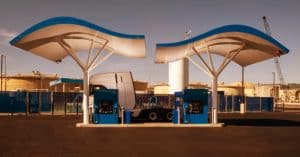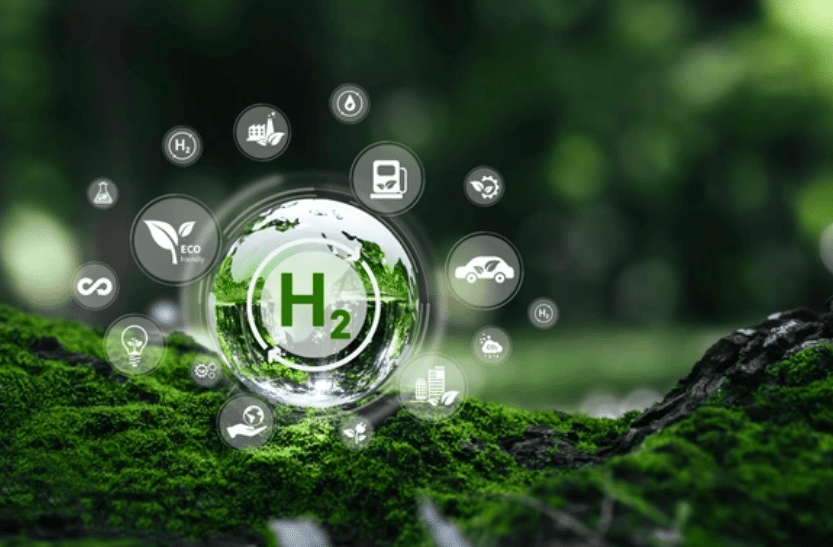The hydrogen sector is seeing transformative developments from two key players. Nikola Corporation is advancing hydrogen fuel cell technology for zero-emission transportation, setting a new standard in sustainable mobility. Meanwhile, PureWave is revolutionizing hydrogen production with innovative, cost-efficient solutions to meet the growing demand for clean energy.
Together, these breakthroughs underscore hydrogen’s pivotal role in decarbonizing industries and powering a greener future.
Nikola and FEF: Setting A New Standard for Hydrogen Transportation
The world’s first hydrogen fuel station for commercial trucks has opened near the Port of Oakland. Built by FirstElement Fuel (FEF), a California-based company, this station boasts a fueling capacity over 10x greater than any existing hydrogen station.
Among its early adopters are Nikola’s hydrogen fuel cell electric trucks, which will refuel at this state-of-the-art facility under a 10-year agreement with FEF.
In December 2023, Nikola Corporation formalized its partnership with FEF, naming the latter an authorized Nikola Fueling Solutions Partner. The collaboration ensures Nikola customers have access to FEF’s cutting-edge hydrogen refueling services, including the new multi-use heavy-duty truck station strategically located near Oakland’s port.

The station is equipped with the world’s first H70 fast-fill lane for heavy-duty trucks. It enables rapid hydrogen refueling in just 10 minutes. This technology allows the station to serve up to 200 trucks daily, supporting the growing fleet of hydrogen-powered vehicles.
The project also received funding from the California Energy Commission under the NorCal Zero Project.
FEF’s founder and executive chairman, Joel Ewanick, highlighted the significance of the partnership, stating:
“This collaboration is a testament to our commitment to transform the transportation industry and we are proud to play a role in powering Nikola’s innovative hydrogen fuel cell electric trucks.”
Nikola’s Role in the Hydrogen Transition
Nikola’s hydrogen fuel cell electric trucks represent a pivotal step in decarbonizing the trucking industry. With access to FEF’s advanced refueling infrastructure, these trucks can efficiently refuel and support long-haul operations, making hydrogen a practical alternative to diesel.
Hydrogen technology has gained interest from other industry leaders, including Hyundai, Daimler, and Volvo. But Nikola’s agreement with FEF positions it as a front-runner in the U.S. hydrogen economy.
The Oakland station is part of a broader push to establish a robust hydrogen infrastructure in the U.S. Tyson Eckerle, clean transportation advisor for California’s Governor, noted that federal funding of $8 billion aims to jump-start the hydrogen economy, with plans for up to 60 more truck stations statewide.
This is where an innovative hydrogen solution of an emerging player comes in – PureWave Hydrogen.
PureWave and the University of Wyoming: Redefining Hydrogen Production
PureWave Hydrogen Corporation has signed a letter of commitment with the University of Wyoming’s Hydrogen Energy Research Center (H2ERC) to advance groundbreaking geologic hydrogen containment technology. This collaboration marks a pivotal step in developing innovative solutions for safely and efficiently storing naturally occurring hydrogen.
PureWave Hydrogen is a pioneering company in the green energy transition, dedicated to discovering and developing naturally occurring hydrogen resources. The company focuses on unlocking the potential of ‘white’ hydrogen to revolutionize the global hydrogen economy.
- White hydrogen is a clean form of hydrogen that eliminates energy-intensive processes to produce.
The company’s partnership with the University of Wyoming provides PureWave access to the institution’s patent-pending synthetic clay suspension technology. This innovative solution, developed by Dr. Saman Aryana’s research group, aims to enhance hydrogen containment by reducing hydrogen diffusivity.
The agreement is part of a proposal submitted to the U.S. Department of Energy’s Advanced Research Projects Agency – Energy (ARPA-E) and is subject to the project’s approval.
Driving Innovation in the Natural Hydrogen Sector
This development underscores PureWave’s commitment to leveraging advanced research to lead the natural hydrogen sector. As global demand for sustainable energy grows, the company is focused on solutions that make hydrogen a secure and viable energy option.
The collaboration with the University of Wyoming’s School of Energy Resources and Chemical and Biomedical Engineering Department highlights a shared mission to advance hydrogen technology and contribute to the green energy transition.
Hydrogen, especially naturally occurring ‘white’ hydrogen, is gaining attention as a clean energy source. With Wyoming’s abundant natural resources and established energy infrastructure, the state could become a hub for hydrogen production.
The Hydrogen Energy Research Center aims to support this transition by exploring innovative hydrogen production methods, including geologic storage, and collaborating with industry leaders like PureWave.
Breakthrough in Hydrogen Containment Technology
At the heart of this collaboration is the synthetic smectite clay, Laponite, a material engineered to significantly improve hydrogen containment. This technology creates a suspension designed to reduce H₂ diffusivity, enabling better storage in geological formations.
Key features of the technology include:
- Synthetic Smectite Clay (Laponite): Reduces the rate at which hydrogen molecules escape, ensuring higher containment efficiency.
- Enhanced Containment: Provides a stable environment for hydrogen production and storage by forming a soft solid upon injection.
- Flexible Application: Suitable for use in vertical and horizontal wells, making it adaptable to various geological conditions.
- Environmental Safety: Minimizes environmental impact while ensuring the secure containment of hydrogen.
Cat Campbell, Head of Geoscience at PureWave, highlighted the importance of this agreement, noting that:
“This agreement represents a significant leap forward in PureWave’s commitment to developing safe and sustainable methods for capturing and storing naturally occurring hydrogen. By partnering with H2ERC, we are now equipped with groundbreaking technology that enhances containment and minimizes the environmental impact of our operations.”
Ultimately, hydrogen’s potential as a clean energy solution is coming to life through advancements by Nikola and PureWave. Nikola’s fuel cell innovations promise zero-emission transportation, while PureWave’s efficient production methods drive accessible, scalable hydrogen energy. Together, these efforts highlight hydrogen’s growing role in global decarbonization and the transition to a sustainable future.



